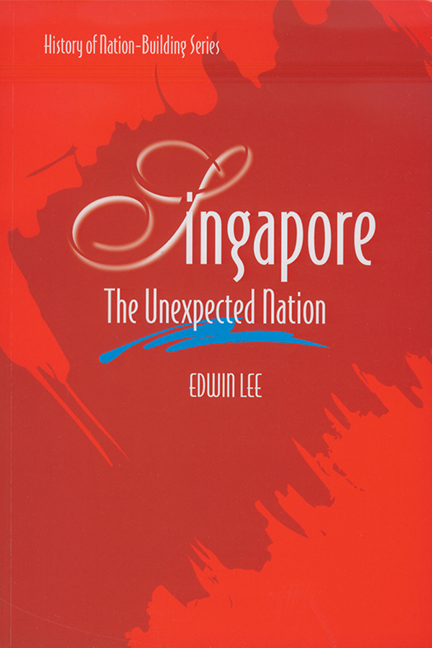Book contents
- Frontmatter
- Dedication
- Contents
- Preface
- Introduction by Wang Gungwu
- Chapter One Beginnings: From Temasek to Singapore
- Chapter Two Race, History and Nationalism
- Chapter Three Contestants and Contesting Visions
- Chapter Four The Accidental Chief Minister
- Chapter Five The Terminal Chief Minister
- Chapter Six The Embattled Prime Minister
- Chapter Seven Merger: Contesting Ownership and Principles
- Chapter Eight Terms of Disendearment
- Chapter Nine Dare to be Equal
- Chapter Ten The Way to Survive
- Chapter Eleven National Service: The Price of Independence
- Chapter Twelve Politics of Education
- Chapter Thirteen Home Ownership, National Stability and the New Middle Classes
- Chapter Fourteen University and Nation
- Chapter Fifteen Toh's Nation-Building Thrust
- Chapter Sixteen Nantah: Between Community and Nation
- Chapter Seventeen Self-Renewal: Talents for a Tough Act
- Chapter Eighteen The Consensual Prime Minister
- Chapter Nineteen Confucianism, Christianity, Chineseness
- Chapter Twenty Singapore Dreams, Singapore Dilemmas
- Chapter Twenty-One The Hyphenated Singaporean
- Chapter Twenty-Two The Unexpected Nation
- Bibliographical Note
- Index
- The Author
Chapter One - Beginnings: From Temasek to Singapore
Published online by Cambridge University Press: 21 October 2015
- Frontmatter
- Dedication
- Contents
- Preface
- Introduction by Wang Gungwu
- Chapter One Beginnings: From Temasek to Singapore
- Chapter Two Race, History and Nationalism
- Chapter Three Contestants and Contesting Visions
- Chapter Four The Accidental Chief Minister
- Chapter Five The Terminal Chief Minister
- Chapter Six The Embattled Prime Minister
- Chapter Seven Merger: Contesting Ownership and Principles
- Chapter Eight Terms of Disendearment
- Chapter Nine Dare to be Equal
- Chapter Ten The Way to Survive
- Chapter Eleven National Service: The Price of Independence
- Chapter Twelve Politics of Education
- Chapter Thirteen Home Ownership, National Stability and the New Middle Classes
- Chapter Fourteen University and Nation
- Chapter Fifteen Toh's Nation-Building Thrust
- Chapter Sixteen Nantah: Between Community and Nation
- Chapter Seventeen Self-Renewal: Talents for a Tough Act
- Chapter Eighteen The Consensual Prime Minister
- Chapter Nineteen Confucianism, Christianity, Chineseness
- Chapter Twenty Singapore Dreams, Singapore Dilemmas
- Chapter Twenty-One The Hyphenated Singaporean
- Chapter Twenty-Two The Unexpected Nation
- Bibliographical Note
- Index
- The Author
Summary
Temasek
A trading settlement began to form in Singapore in the late thirteenth century and grew in importance in the fourteenth century. This was Temasek, whose people were Malays, Orang Laut and Chinese. The Malays were the rulers who opened the port, for trade generates taxes and gifts and attracts foreign traders and people, increasing the population, all of which would contribute to the wealth and prestige of their kingdom. The Orang Laut, Malay for “Sea People”, were directed by the Malay rulers and chiefs to man war fleets and to harvest produce from the resource-rich marine environment. There was a market for this produce in China. This is important because the trade of Temasek depended on imports of Chinese silks, cottons, ceramics, iron cauldrons, and other goods brought by the junks of the “Chuan-chou traders”. Temasek also had resident Chinese merchants interested in, among other items, the “black wood” found on the island.
Chinese writers of the fourteenth century knew of a place they called Lung-ya-men, the “Dragon's Tooth Strait”. It is on record that the Yuan dynasty of China sent envoys to this place in 1320 “to obtain tame elephants”, and that “the people of Dragon's Tooth Strait” sent a tribute and trade mission to the Yuan court in 1325.
Some five years later, the Dragon's Tooth Strait appeared again in the itinerary of a Chinese merchant who came to Southeast Asia. He has given the fullest contemporary account of the place of which the point that will be highlighted here is his culture-centric reference to “the Tan-ma-hsi barbarians” which helps to clinch the identification of Temasek with the Dragon's Tooth Strait.
Where in modern Singapore is the Dragon's Tooth Strait? One scholar states that it is “the western entrance to Keppel Harbour, the narrow stretch of water which passes between Labrador Point and Sentosa Island”. Another scholar locates it at “the Singapore Main Strait, about 15 km south of Singapore”. In either case, the inference is that, by the fourteenth century, a waterway at Singapore had become the main route for ships going from the South China Sea to the Straits of Malacca and beyond.
The people of Temasek had the Singapore River as an artery of trade.
- Type
- Chapter
- Information
- SingaporeThe Unexpected Nation, pp. 1 - 20Publisher: ISEAS–Yusof Ishak InstitutePrint publication year: 2008

